#diode rectifier circuit
Explore tagged Tumblr posts
Text
Schottky Diodes recovery, Schottky bridge rectifier, power management circuits
PMEG4030 Series 40 V 3 A Low VF MEGA Schottky Barrier Rectifier - SOD-123W
0 notes
Text
High-Performance Rectifier Diode: IXYS MDO500-12N1 for Industrial Applications
For professionals in need of high-efficiency rectifiers with superior power handling, the MDO500-12N1 stands out as a reliable choice. Officially distributed by https://www.uscomponent.com/buy/IXYS/MDO500-12N1, this diode ensures easy access to high-quality components from a trusted supplier. Explore the possibilities it brings to your industrial power systems with IXYS Power Transistor Modules and other advanced components from IXYS Corporation.
The MDO500-12N1 is a robust rectifier diode manufactured by IXYS Corporation, designed for high-power applications requiring efficient conversion of alternating current (AC) into direct current (DC). With a maximum voltage rating of 1200V and the ability to handle a continuous forward current of 500A, this diode delivers exceptional performance in demanding industrial environments.
Featuring a low forward voltage drop, the MDO500-12N1 minimizes power losses, ensuring enhanced efficiency in rectification circuits. Its high surge current capability makes it ideal for applications that experience power surges, such as welding machines, battery chargers, and industrial power supplies.
Packaged in a standard rectifier diode format, this device includes two terminals: one for the input AC signal and one for the output DC signal. It incorporates built-in protection features such as reverse voltage protection and over-temperature protection, ensuring reliable operation and safeguarding against potential damage.
The IXYS MDO500-12N1 is particularly suited for rectification circuits demanding high power handling capabilities and efficient performance. As part of IXYS Corporation's product line, this rectifier diode is a trusted solution for industrial equipment requiring high performance, durability, and protection.
#Rectifier Diode#Full Bridge Rectifier#Diode Bridge Rectifier#Bridge Rectifier Circuit#IXYS#IXYS Authorized Distributors#IXYS Bridge Rectifier#MDO500-12N1#IXYS Distributor#IXYS Rectifier Bridge#IXYS MDO500-12N1
0 notes
Text
https://www.futureelectronics.com/p/semiconductors--discretes--diodes--schottky-diodes/zhcs1000ta-diodes-incorporated-2129437
Recovery diode, high frequency, ON Semiconductor, what is a Schottky Diode
ZHCS1000 Series 1000 mA 40 V 100 uA High Current Schottky Barrier Diode - SOT-23
#Diodes#Schottky Diodes#ZHCS1000TA#Diodes Incorporated#Recovery diode#high frequency#ON Semiconductor#Power Schottky rectifier#Semiconductor diode#power supplies#recovery diode#Power management circuits#Schottky rectifiers chip#voltage
1 note
·
View note
Text
https://www.futureelectronics.com/p/semiconductors--discretes--diodes--scottky-rectifiers/pmeg4050ep-115-nexperia-4951570
TV tuners, high frequency, power management circuits, power supplies
PMEG4050 Series 40V 3 A Low VF MEGA Schottky Barrier Rectifier - SOD-128
#Diodes#Schottky Rectifiers#PMEG4050EP#115#Nexperia#TV tuners#high frequency#power management circuits#power supplies#Switching Diodes#Semiconductor diode#power circuits#switching#Power management circuits#Recovery diode
1 note
·
View note
Text
https://www.futureelectronics.com/p/semiconductors--discretes--diodes--standard-rectifiers/1n4148wtq-7-diodes-incorporated-4041450
Diodes, Standard Rectifiers, 1N4148WTQ-7, Diodes Incorporated
1N4148WT Series 2 A 80 V 150 mW Surface Mount Fast Switching Diode - SOD-523
#Diodes#Standard Rectifiers#1N4148WTQ-7#Diodes Incorporated#what is a rectifier#AC to DC Converters#chip#circuit#Standard Recovery Power Rectifier#bridge rectifier#Half Wave Controlled Rectifier#Diode rectifier circuits
1 note
·
View note
Text
https://www.futureelectronics.com/p/semiconductors--discretes--diodes--scottky-rectifiers/pds5100-13-diodes-incorporated-6129425
What is Diode, high frequency, high Voltage Schottky Barrier Rectifier
PDS5100H Series 100 V 5 A High Voltage Schottky Barrier Rectifier - PowerDI-5
#Diodes Incorporated#PDS5100-13#Diodes#Schottky Rectifiers#High speed rectifier diodes#Microwave diode#RF Diode#high frequency#high Voltage Schottky Barrier Rectifier#circuit#Recovery diode#Schottky bridge rectifier#rectifier chip
1 note
·
View note
Text
https://www.futureelectronics.com/p/semiconductors--discretes--diodes--scottky-rectifiers/pds5100-13-diodes-incorporated-7587892
Reverse recovery time, power management circuits, High speed rectifier diodes
PDS5100H Series 100 V 5 A High Voltage Schottky Barrier Rectifier - PowerDI-5
#Diodes#Schottky Rectifiers#PDS5100-13#Diodes Incorporated#PN#junction rectifiers#Recovery diode#Voltage Schottky Barrier Rectifier Power#reverse recovery time#power management circuits#High speed rectifier diodes#low forward voltage drop
1 note
·
View note
Text
https://www.futureelectronics.com/p/semiconductors--discretes--diodes--scottky-rectifiers/pds5100h-13-diodes-incorporated-9401746
High Voltage Schottky Barrier Rectifier, Fast rectifier diode, power diode
PDS5100H Series 100 V 5 A High Voltage Schottky Barrier Rectifier - PowerDI-5
#Diodes Incorporated#PDS5100H-13#Diodes#Schottky Rectifiers#Power management circuits#ultra high-speed#bridge rectifier#High Voltage Schottky Barrier Rectifier#Fast rectifier diode#power diode#Rectifier power circuits#Microwave diode#RF
1 note
·
View note
Text
https://www.futureelectronics.com/p/semiconductors--discretes--diodes--schottky-diodes/bat54cw-7-f-diodes-incorporated-1106541
RF detector diode, Schottky Barrier Diode, Hot carrier diode, Schottky rectifier
BAT54W Series 30 V 600 mA Surface Mount Schottky Barrier Diode - SOT-323
#Diodes Incorporated#BAT54CW-7-F#Diodes#Schottky Diodes#voltage drop#Surface Mount Schottky Barrier Diode#RF detector diode#Hot carrier diode#Schottky rectifier#Recovery diode#Power diode#diode chip#Power management circuits
1 note
·
View note
Text
https://www.futureelectronics.com/p/semiconductors--discretes--diodes--scottky-rectifiers/pmeg4050ep-115-nexperia-4951570
Low voltage, high frequency rectification, voltage drop−reverse current tradeoff
PMEG4050 Series 40V 3 A Low VF MEGA Schottky Barrier Rectifier - SOD-128
#Nexperia#PMEG4050EP#115#Diodes#Schottky Rectifiers#schottky power rectifier#Recovery diode#low voltage#high frequency rectification#voltage drop−reverse current tradeoff#power management circuits#product#barrier rectifiers
1 note
·
View note
Text
https://www.futureelectronics.com/p/semiconductors--discretes--diodes--scottky-rectifiers/pmeg4050ep-115-nexperia-5015646
Recovery diode, regular power diodes Schottky barrier rectifiers, power circuits
PMEG4050 Series 40V 3 A Low VF MEGA Schottky Barrier Rectifier - SOD-128
#Diodes#Schottky Rectifiers#PMEG4050EP#115#Nexperia#Schottky rectifiers product#power management#power supplies#Switching Diodes#Semiconductor diode#power circuits#Recovery diode#regular power diodes
1 note
·
View note
Text
https://www.futureelectronics.com/p/semiconductors--discretes--diodes--schottky-diodes/bat54sw-13-f-diodes-incorporated-1129353
Diodes, Schottky Diodes, BAT54SW-13-F, Diodes Incorporated
BAT54W Series 30 V 0.2 A Surface Mount Schottky Barrier Diode - SOT323
#Diodes#Schottky Diodes#BAT54SW-13-F#Diodes Incorporated#power supplies#Switching Diodes#TV tuners#high frequency#power circuits#schottky bridge rectifier#power management circuits#Recovery diode
1 note
·
View note
Text
https://www.futureelectronics.com/p/semiconductors--discretes--diodes--schottky-diodes/bat54swt1g-onsemi-1206325
Onsemi, BAT54SWT1G, Diodes, Schottky Diodes
BAT54SWT1G: 30 V 200 mA SMT Dual Series Schottky Barrier Diode - SOT-323
#Onsemi#BAT54SWT1G#Diodes#Schottky Diodes#Diode manufacturers#Schottky barrier diodes#digital logic circuit#hot carrier diode#fast switching recovery diode#chip#Schottky diode voltage drop#Schottky power rectifier
1 note
·
View note
Text
RF Diodes, Surface Mount Schottky Power Rectifier, high frequency,
PDS5100 Series 100 V 5 A High Voltage Schottky Barrier Rectifier - PowerDI-5
#Diodes#Schottky Rectifiers#PDS5100-13#Diodes Incorporated#schottky bridge rectifier#MEGA Schottky Barrier Rectifier#what is a Schottky#power circuits#Power management circuits#RF Diodes#Surface Mount Schottky Power Rectifier#high frequency
1 note
·
View note
Text
Schottky barrier rectifiers, High Voltage Schottky Barrier Rectifier, Switching Diodes
PDS5100 Series 100 V 5 A High Voltage Schottky Barrier Rectifier - PowerDI-5
#Diodes Incorporated#PDS5100-13#Diodes#Schottky Rectifiers#power management circuits#Recovery diode#High Voltage Schottky Barrier Rectifier#Switching Diodes#What is a Schottky rectifier#power supplies#TV tuners#high frequency
1 note
·
View note
Note
tell me everything about AC to DC filters Right Now
:0
Dear god.
OK I have to make some assumptions or else this is going to get really long. I am going to assume that you already know what AC and DC are. I am going to assume that you took (and passed) geometry, so a sine wave and it's variations are familiar to you. I am also going to assume that you also know the difference between voltage, current, and resistance.
So, what are AC to DC, why do we care about that? Well, the electricity coming out of the wall is AC, but in order to, lets say, charge your laptop battery, you need DC. In fact, if you look at a laptop charger, you'll see The Brick. The thick rectangle that gets hot when charging the laptop.
THAT'S THE AC TO DC CONVERTER
I just called it converter instead of filter. Why? Because filters technically only remove a 'ripple' from DC current, so a current that's almost DC but not quite. If you are making the entire jump from AC to DC, then that's called a converter.
Now here's where things get fucked.

These are all of the parts after the plug. The load is your laptop, the regulator is your filter.
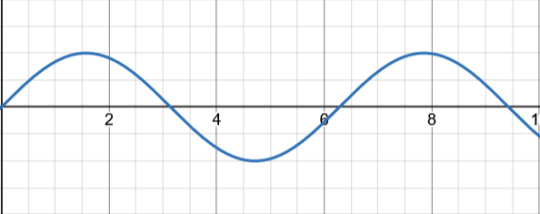
Let's say that this is your AC signal (this graph showing the voltage over time). Now, the first thing this passes through is the transformer, which only adjusts the voltage to the correct level. Some devices need it higher, some lower. Let's say that this transformer is a step up transformer, because it made the signal bigger.

The next step is the rectifier. Now, traditionally this part is taught in stages in order to show it's affect on the signal. I'm going to speed run that. I will assume that you're familiar with what a diode is. If you aren't, just know that it only allows current to flow in one direction. So, anything going backwards will be removed. Picture a one way valve.
So, if we were to send this signal through one diode, then that would leave us with
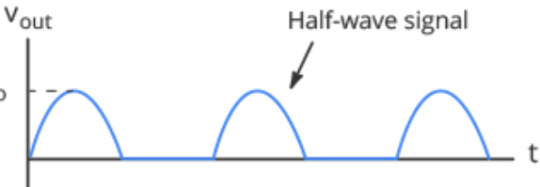
just the positive half! That's why this setup is called a Half-wave rectifier.
But what if we were to use two diodes. As in, fill in the blank spot that the negative half left with another positive bump. That would give us

This lovely thing! Which is great, but it requires another AC signal that is 180 degrees off from the original one in order to exist. Which, transformers exist which can provide that, but it's not cost effective. So, that leaves us with the most common setup, the Bridge Rectifier.
I've been skipping the circuit diagram so far, but now it's important.
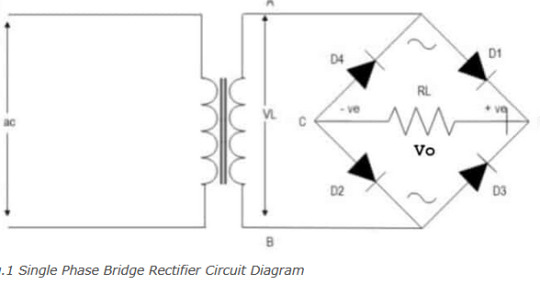
THIS thing is a bridge rectifier connected to the transformer (yes that's what transformers look like according to circuit diagram shorthand). Now, I am American, and for some reason American electricians use that up and down sharp thing in the middle of the diamond to indicate a resistor. Europe uses a rectangle. Again, I am going to assume that you know what a resistor does.
Those four black triangles with lines? Those are diodes. The line across the tip of the triangle indicates what direction they are allowing current to flow into. Now picture you were a positive signal flowing in through point A into the bridge. There's a split in the circuit, but one way (diode D4) is blocked, so you have to go across diode D1. Now you're at the edge of the diamond, once again two ways you can go. You head towards diode D2, because diode D3 won't let you through. What that looks like is this
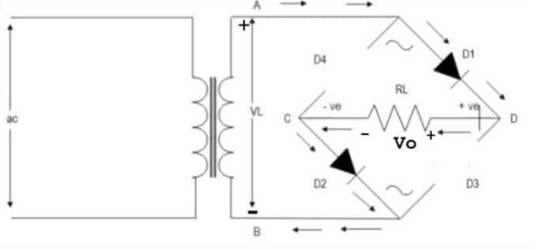
What about the other direction? Well that looks like
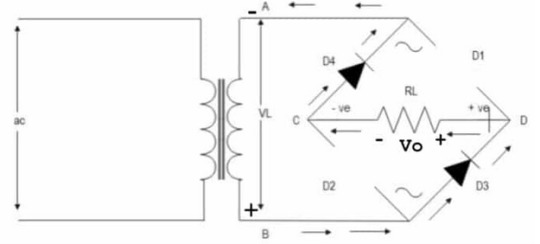
Notice that the edges of the diamond are called out? Points C and D. That's the money makers. You see, if you plug into point D as your positive and C as your negative, you get a full wave signal! (so sorry for not going fully in depth on why that works just trust me it's a bit of a mess and should really be taught with the actual circuit in front of you, not across the internet like this)
A full wave signal is completely positive, but it's not exactly DC yet. That's where smoothing comes in. This is done with a capacitor!

The capacitor is charged up and then slowly releases it's charge. But before it can completely discharge, it gets recharged by the next wave. Quick review, a capacitor is like a battery where it can be charged up, but unlike a battery which holds charge with chemistry, capacitors hold charge with physics. They can still wear out, but not nearly as quickly as a battery.
What does that red line look like? Well, almost like a straight line, except it has RIPPLES! That's right, we're finally back to the filter! Or the regulator as the diagram calls it. Means the same thing.
Sometimes, this step is skipped. If the device getting signal isn't too sensitive or it's just cheep, then the electricity stays bouncy. Some devices really care about any fluxuation in the signal, in which case they get a big expensive filter.
Unfortunately, the inner bits of a filter are many, so I won't be going into all of that. But you want me to go into that, so I will show a circuit diagram.
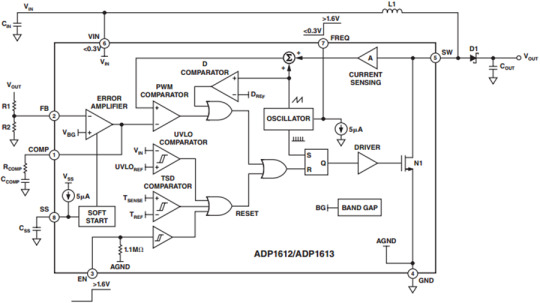
This is a diagram of the ADP1612
This website has a downloadable version of the spec sheet!
But that's a level of detail that you usually only get into if you are planning on building a circuit. The day that you're flipping through spec sheets in order to check compatibility is when you've really become an engineer.
So that's how you go from AC into DC. Yes, I just spent an hour typing this all out. I like electricity a lot.
Here's a GREAT video that goes over all of this but the guy actually has a circuit and an ossiliscope in front of him to show the signal.
#electricity#electronic#electrical engineers#physics#AC to DC rectifier#electrical engineering#mmm electricity for power#ask#literally several college classes worth of info that I am skipping in this#ough my circuit bits#I chose the perfect degree I am built for this shit
10 notes
·
View notes